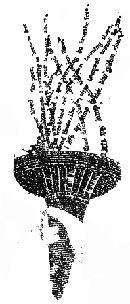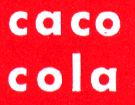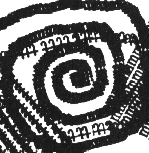 CONCRETE POETRY
CONCRETE POETRY
The term concrete poetry was coined
simultaneously in the early fifties by Eugen Gomringer in Switzerland and
Öyvind Fahlström in Sweden
[1]. Gomringer had
known several concrete painters in the forties -- in particular Max Bill, to
whom he eventually became secretary. In 1953, Gomringer published a book of
spatially structured poems that used only one word and which the arrangement of
this word on the page signified the poem's meaning. These he called
constellations and they were part of the concrete movement which Bill
represented but also were part of a long tradition of visual poetry which
stretched back to include such artists as Ezra Pound
[2], Theo Van Doesburg
[3], Guillaume Apollinaire
[4], Stephane Mallarmé
[5], Charles L. Dodgson (Lewis Carrol)
[6], George Herbert
[7], and further back to the beginnings of
writing itself [8].
 At the same time as
Gomringer was developing poetry emphasizing the visual aspects of words, a
group of three poets in Brazil, Haroldo de Campos, Augusto de Campos and
Décio Pignatari formed the group Noigandres
[9]. They defined a poetry which explored the
ideogram as a three-dimensional, verbivocovisual object
[10]. They produced a literary magazine
Invençao in which they published their experimental work which
Haroldo de Campos began to call Poesia Concreta in 1955, and from which
the term concrete poetry was derived to described this type of work from
the late fifties through the sixties.
At the same time as
Gomringer was developing poetry emphasizing the visual aspects of words, a
group of three poets in Brazil, Haroldo de Campos, Augusto de Campos and
Décio Pignatari formed the group Noigandres
[9]. They defined a poetry which explored the
ideogram as a three-dimensional, verbivocovisual object
[10]. They produced a literary magazine
Invençao in which they published their experimental work which
Haroldo de Campos began to call Poesia Concreta in 1955, and from which
the term concrete poetry was derived to described this type of work from
the late fifties through the sixties.
Concrete poetry had been developed
independently a few years earlier, by Swedish artist Öyvind Fahlström
who wrote a Manifesto for Concrete Poetry in 1953
[11] to describe a poetry which intended to
use words much as a painter would use representational forms. The manifesto
anticipated both the term for and many of the features of a new visual
linguistic art form. It appears that neither Gomringer or Noigandres had any
knowledge of Fahlström's manifesto which had only been circulated in
Swedish in mimeographed form.

 Influences
between sound poetry and visual poetry form an intricate interchange of ideas.
Many practitioners have done and do both kinds of art. The historical maze gets
even more dense when one realizes that not only were Gomringer and Noigandres
influenced by Concrete Art, but Fahlström had probably been
influenced by Pierre Schaeffer's development of musique
concrète as well. The relationship between these two ways of
working, continues to be a complex one [12].
Influences
between sound poetry and visual poetry form an intricate interchange of ideas.
Many practitioners have done and do both kinds of art. The historical maze gets
even more dense when one realizes that not only were Gomringer and Noigandres
influenced by Concrete Art, but Fahlström had probably been
influenced by Pierre Schaeffer's development of musique
concrète as well. The relationship between these two ways of
working, continues to be a complex one [12].

Last Modified 20 January 1998
 CONCRETE POETRY
CONCRETE POETRY 

